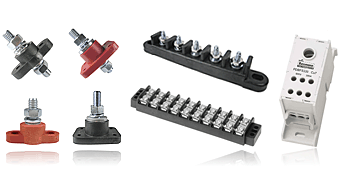Junction Blocks & Terminal Blocks
Automotive Junction Blocks
Terminal Wiring Blocks
Terminal Block Accessories
A terminal block (or junction block) provides an easy way to connect electrical cable(s) to a device or electrical cables together to make a single electrical circuit. Whilst terminal blocks come in many different shapes and sizes, they typically feature an insulating body with one or more metal clamping areas. The electrical cables are connected to the clamping area which is designed to conduct electricity between all the connected cables. The insulating body of the terminal block may provide options to mount the terminal block or enclose the clamping area to reduce the possibility of physical contact. Terminal blocks may be single pole or multi-pole. Each pole of the terminal block is independent and designed to join multiple electrical cables as a single electrical circuit. Terminal blocks provide a neat, secure and simple way to connect electrical cables together. Some blocks offer labelling features to allow identification of each circuit.
How does a Terminal Block work?
Terminal blocks (or junction blocks) work by connecting electrical cable(s) to a device or electrical cables together to make a single electrical circuit. This is achieved by securing the conductor of each cable to a common clamping area on the terminal block. The clamping area and clamping mechanism vary depending on the design of the terminal block. Common designs include:
- Cables clamped inside a metal enclosure by fixing screws.
- Cables clamped inside a metal enclosure by a spring loaded metal tab.
- Cables clamped to a metal surface using a nut or screw.
What is a Terminal Block Used for?
Terminal blocks (or junction blocks) are used to connect electrical cable(s) to a device or electrical wires together to create a single circuit. Terminal blocks are used in a huge variety of electrical applications such as domestic and commercial electrical installations. These installations use terminal blocks to join multiple individual electrical cables together to form electrical circuits. Terminal blocks are also fitted inside electrical devices such as wall switches and light fittings so electrical cables can be connected to the device. The terminal block provides and easy and quick way to connect or disconnect devices and electrical cables. There is no requirement to cut or solder cables each time the electrical device is replaced.
What Amp Terminal Block Should I Use?
Each terminal block (or junction block) is designed to operate below a specific ampere current rating. Before selecting a terminal block, you first need to know the maximum operating current of the electrical cable you wish to connect to the terminal block. If you install a terminal block that is rated below the maximum operating current of your circuit, you risk overheating which can damage the terminal block and the connection. Once you have established the maximum current of the circuit, select a terminal block that is rated at 150% of the maximum current. eg. If the maximum current in the circuit is 10A, then a terminal block rated at 15A should be suitable. We also recommend the circuit is protected by a fuse to protect against short circuits or overloads. Finally you need to check the terminal block will suit the gauge of the electrical cable you wish to connect.
Swe-Check sell a range of quality junction blocks which are perfect for terminating or joining electrical cables at a single point in the wiring installation. There are several options available including feed-thru which passes electrical connections between panels like a firewall. Our blocks are available in single or multiple pole configurations depending on how many circuits you wish to connect.
Stud mount blocks allow you to quickly connect wires that are terminated with ring type terminals, alternatively our screw type blocks allow you to connect stranded or solid cable that is not terminated with ease.
Our DIN rail mounted terminal blocks feature screw connectors and the narrow profile body allows you to setup many poles in a small area. They are available to suit cable sizes 2.5 to 6mm2 and rated up to 40A at 1000V.







